On View
Sadie Barnette Has Made Art From the Files the FBI Kept on Her Father. Now She’s Recreating His Path-Breaking Nightclub
The artist continues her excavation of the personal and the political at the Kitchen in New York.
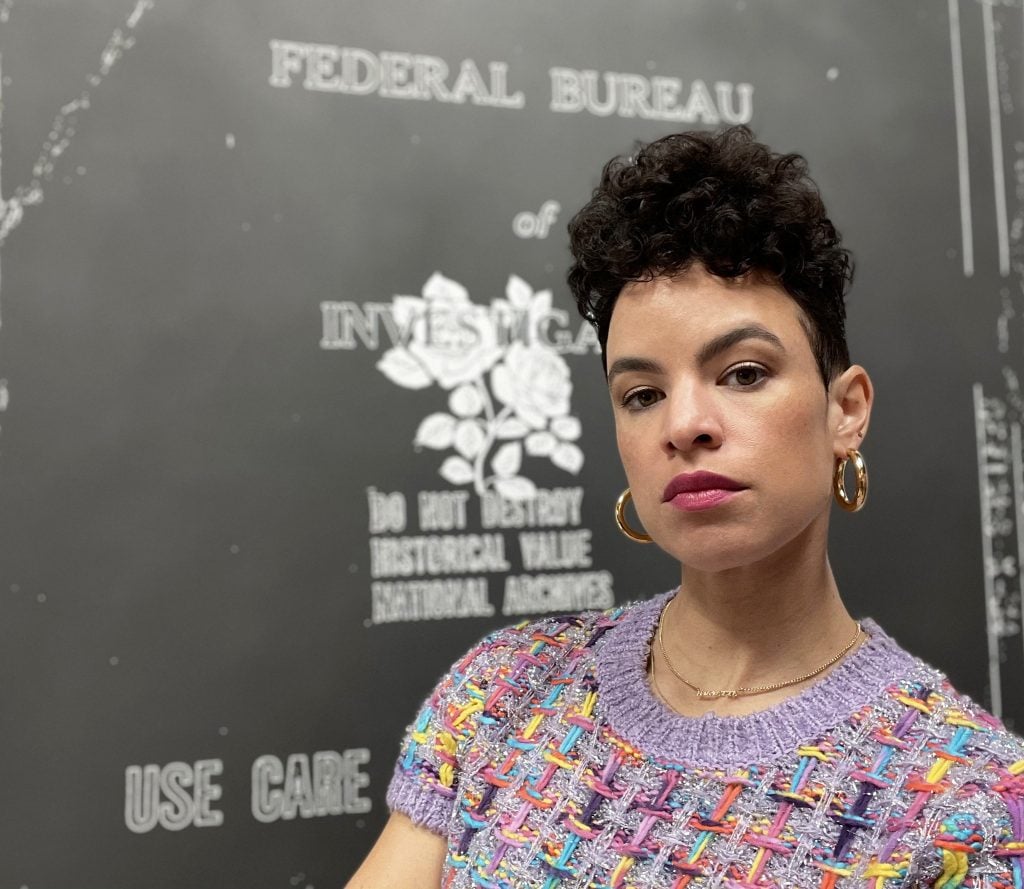
The artist continues her excavation of the personal and the political at the Kitchen in New York.

Melissa Smith

The gallery for Sadie Barnette’s current exhibition at the Kitchen is practically pitch black—except for a horseshoe bar ringed with stools. Barnette’s re-creation of the New Eagle Creek Saloon—a gay bar and nightclub, the first Black-owned one in San Francisco, which her father, Rodney Barnette, ran from 1990 to 1993—sits in the middle of the room, lit up in neon pink and purple.
When I visited the celebrated art institution in New York’s Chelsea neighborhood, where Barnette’s installation will be on view through March 6, a family with two young children walked in behind me. They let out a collective gasp. The kids ran up to the installation, instantly amused by seeing their reflections in the mirrored bar. They then stood in front of the installation, underneath the neon “Eagle Creek” sign and near the glittered boom box they’d just been gawking at, and signaled for their parents to take a picture. After that, they all left.
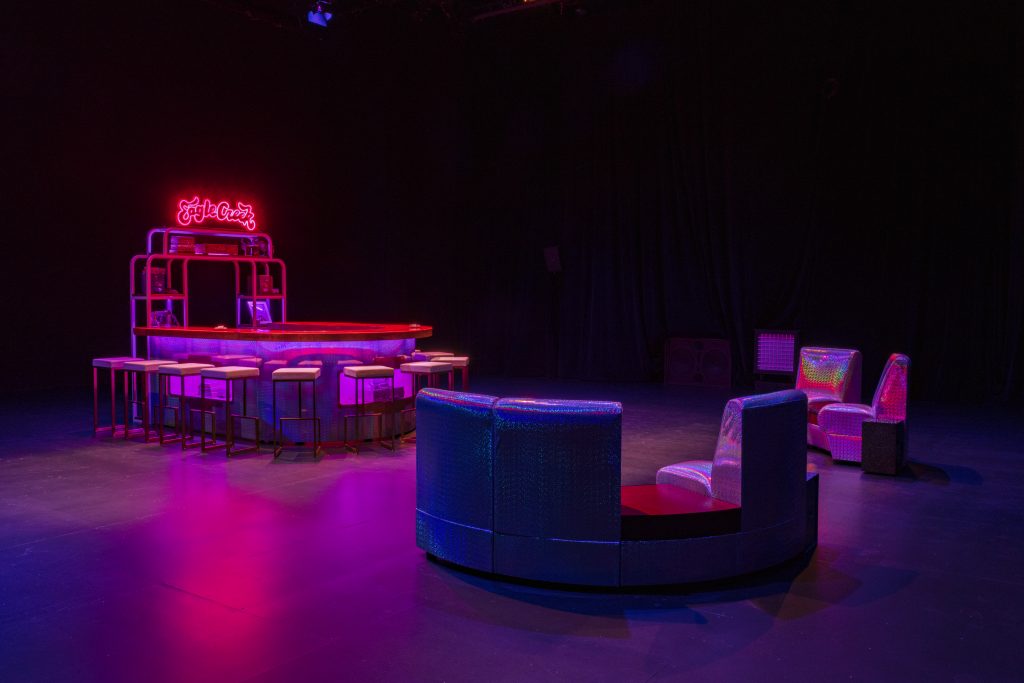
Installation view, Sadie Barnette, “The New Eagle Creek Saloon,” at the Kitchen, New York. Photo: Adam Reich.
And this is what the installation will be for a lot of people. It’s dramatic. It’s fun. It sparkles. On the days when madison moore, assistant professor of queer studies at Virginia Commonwealth University and the Kitchen’s first nightlife and club culture resident, is hosting DJ events in the gallery, it’ll be a raucous dance party, invoking the spirit of queer nightlife.
As Barnette sees it, expressions of pleasure and joy are legitimate responses to the work—the bar, in its day, generated quite a bit of both for its patrons. Digging a little deeper into “New Eagle Creek,” though, there is far more to the installation than first meets the eye—which is why, in the last two years, it has traveled to venues including the Lab in San Francisco and the Institute of Contemporary Art in Los Angeles. This presentation at the Kitchen, and in collaboration with the Studio Museum in Harlem, is its first on the East Coast.
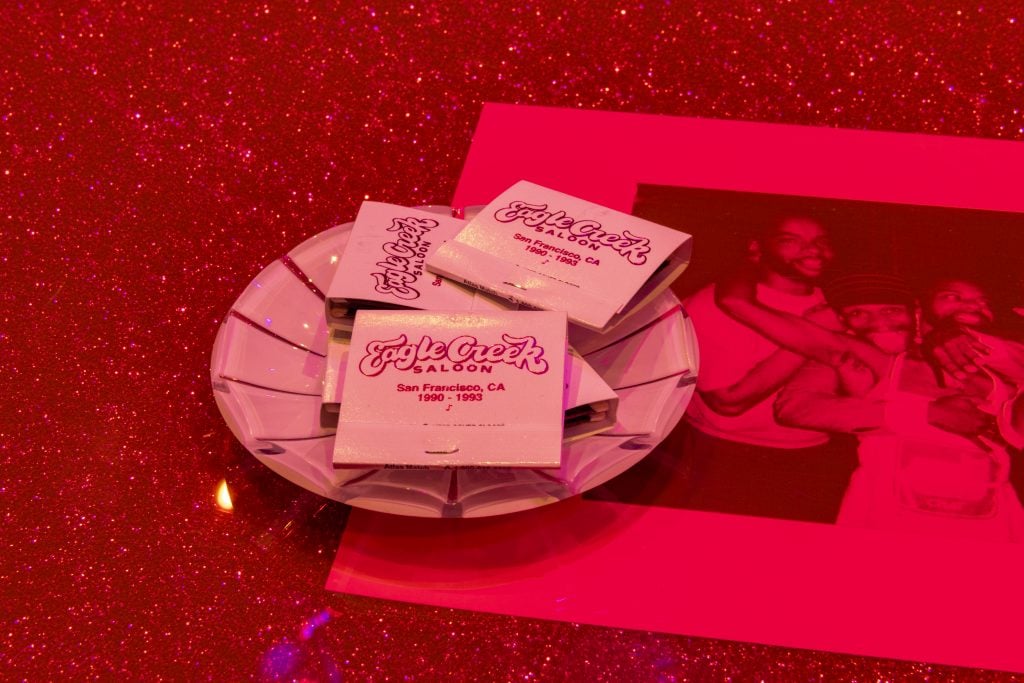
Installation view, Sadie Barnette, “The New Eagle Creek Saloon,” at the Kitchen, New York. Photo: Adam Reich.
Sadie, now 37, was seven years old when her dad first took her to the New Eagle Creek Saloon on Market Street. At the time, the bar was sponsoring a float for the 1992 San Francisco Pride Parade.
Rodney opened the bar “because of the racism that he and his multiracial group of gay friends experienced at white gay bars in San Francisco,” Barnette explains. “So it really was out of necessity—for the dignity of being cute and Black and gay in San Francisco in the 1990s that he set up this bar. And it really ends up being kind of a community center, a safe haven.”
As Barnette remembers it, the theme for the float was “Black people through the ages.” She was dressed up as a Black Victorian. The event conjures up memories of being surrounded by an exuberant group of Black pharaohs and Black robots and Black astronauts. It was like being a part of the Black past, present, and future, all at once. From that moment on, the bar lived on in her imagination as a “larger than life; a mythical, fantastical space,” she recalls. “So it didn’t make sense to make my installation look like the original bar. It made sense to make it look like me dreaming in my aesthetic about the bar.”
The “New Eagle Creek Saloon” was hardly the first time Barnette has pulled from her family’s history for her work. Back in high school, she says she took up photography as “a way of seeing the world or a way of engaging with the world as a witness”; realizing how political even her own personal history was, she has nurtured a documentary impulse ever since. “I was entranced by the stories and the performing of stories and the gatherings and the history and seeing so much of American history contained just within the living room,” she says.
In the last five years or so, the Oakland-based artist has centered her practice on her father’s past. In 2011, when Barnette was working on her MFA at the University of California, San Diego, her father suggested that they submit a Freedom of Information Act (FOIA) request to obtain the surveillance file the FBI had once compiled on him. In the 1960s and ‘70s, Rodney was a Black Panther. He founded the Compton chapter of the organization in 1968; stood guard for Angela Davis as she awaited trial for murder, kidnapping, and conspiracy in 1970; and was for years deeply involved in Black revolutionary activism.
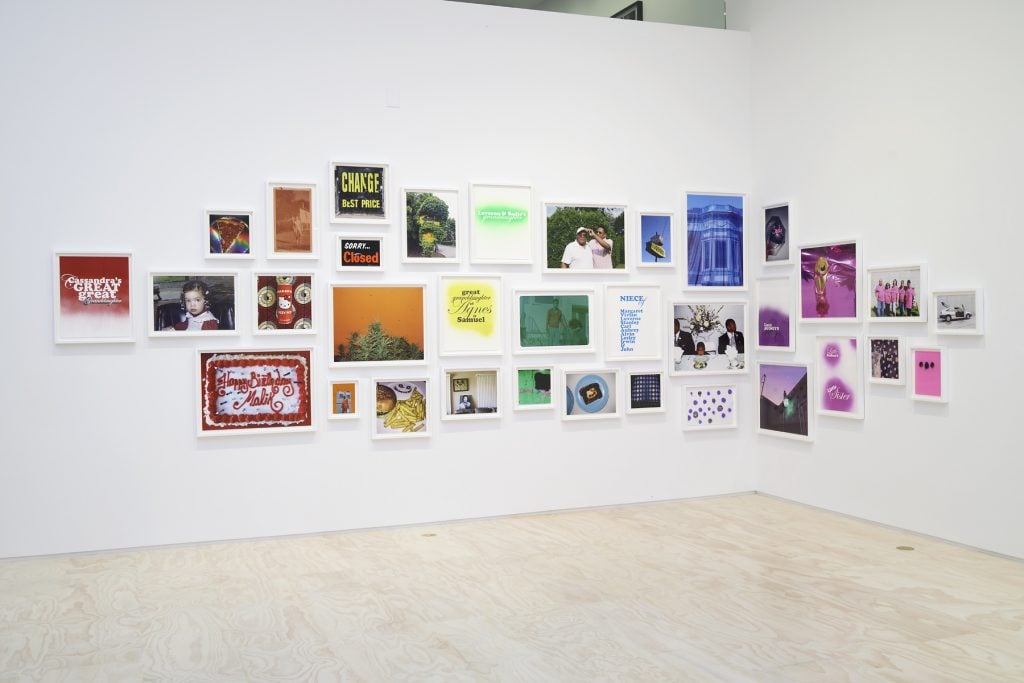
Sadie Barnette, Family Tree (2021). Courtesy of the artist and Jessica Silverman, San Francisco. Photo: John Wilson White.
“I figured the [FOIA documents] would make [their] way to being a part of my work, since my work has always been centered around my family,” Barnette says.
Her father’s past, in particular, provides direct links to significant movements in Black history still left largely untold, such as the extent to which the Black Panthers influenced American politics and how Black people were active participants in the rise of LGBTQ culture of the late 1980s and early ’90s.
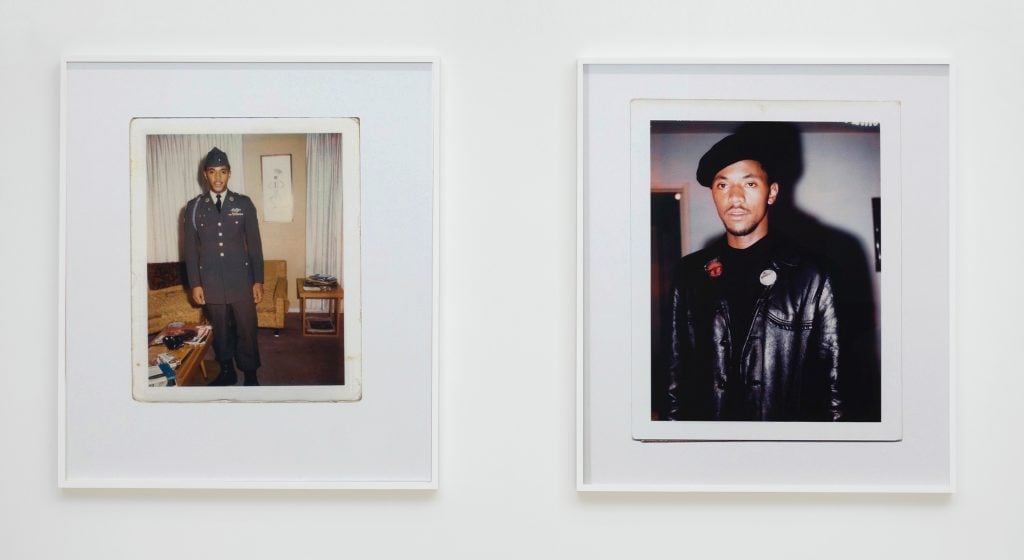
Sadie Barnette, Untitled (Dad, 1966 and 1968). Courtesy of the artist and Jessica Silverman, San Francisco.
When the FBI documents—500 pages in total, covering seemingly mundane but also intensely private details of her father’s life—arrived four or five years later, Barnette started integrating them into her practice; first, as material in her first solo show in San Francisco, at Jenkins Johnson Gallery in 2016—which ran concurrently with her installation of similar work in a group exhibition at the Oakland Museum of California—and then within countless other shows over the years. In her approach, she doesn’t just display the documents as is. She manipulates them; she marks them up with spray paint, decorates them, tarnishes them—but never lets them escape her personal touch. By doing this, Barnette folds her voice into the construction of her dad’s legacy. She reclaims the parts of the documents that make no sense to her. Because she’s never seen her father as a threat. He’s always just been her dad.
“The project that she did with the FOIA act that she submitted for her father,’” says Legacy Russell, executive director and chief curator at the Kitchen, “that body of work has since become really instrumental and a turning point across her process.”
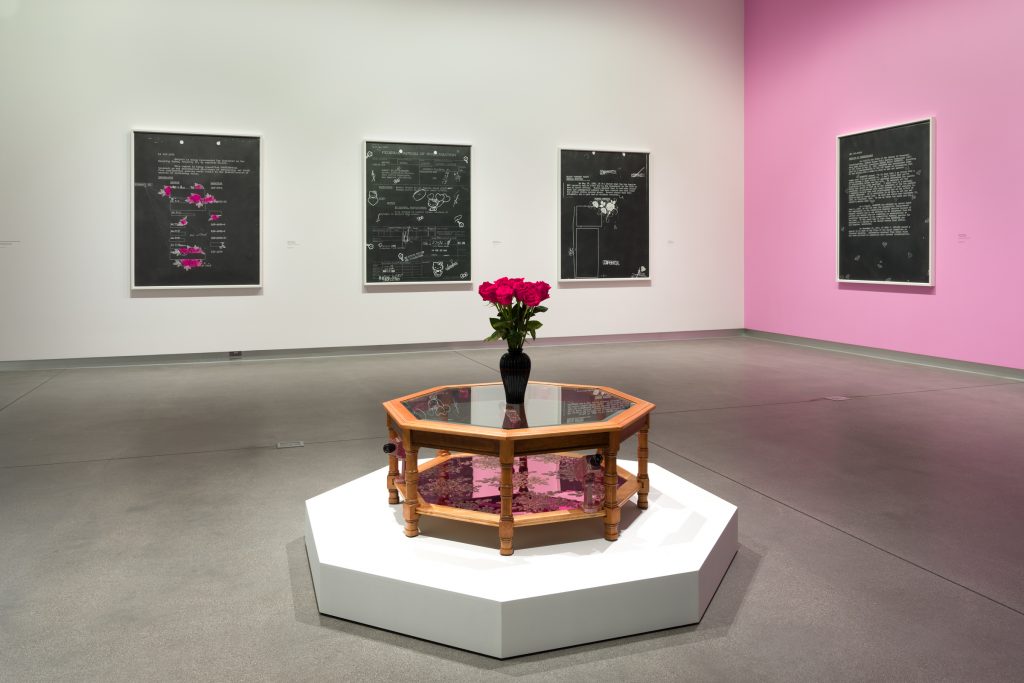
Installation view of “Sadie Barnette: Legacy and Legend” at the Benton Museum of Art at Pomona College, July 22–December 18, 2021. This exhibition was co-organized with Pitzer College Art Galleries. Photo: Fredrik Nilsen Studio.
And in recent years, her projects have become even larger and more ambitious in scale—while still directly tied to her father’s life.
“I knew my dad had this amazing history with his bar. But the story was almost lost to history,” Barnette notes. So why not, she thought, also focus on this other profound period in Rodney’s life? Lately, though, she’s also “really looking to and is excited about fusing those narratives together,” says her dealer Jessica Silverman, “so that they don’t become these two separate issues. They became part of a whole, because that is who he is.”
The two narratives might not be so separate anyway. As Barnette puts it, Rodney’s engagement with many different communities—especially marginalized ones—is “just a part of the way that my father moves through the world,” she says, “whether it’s fighting for Angela Davis’s freedom or hosting a bar, I think it’s all about protecting the people.” Barnette’s forthcoming installation at Los Angeles International Airport, scheduled to be unveiled in 2024, will pay homage to efforts to shelter Davis while she was sought by the FBI.
“Here’s one thing that my father said to me that I really appreciated,” Barnette says. “He’s like: when you read the history books, you don’t necessarily need to see your name there, but you just want to know that you were there and participated.”
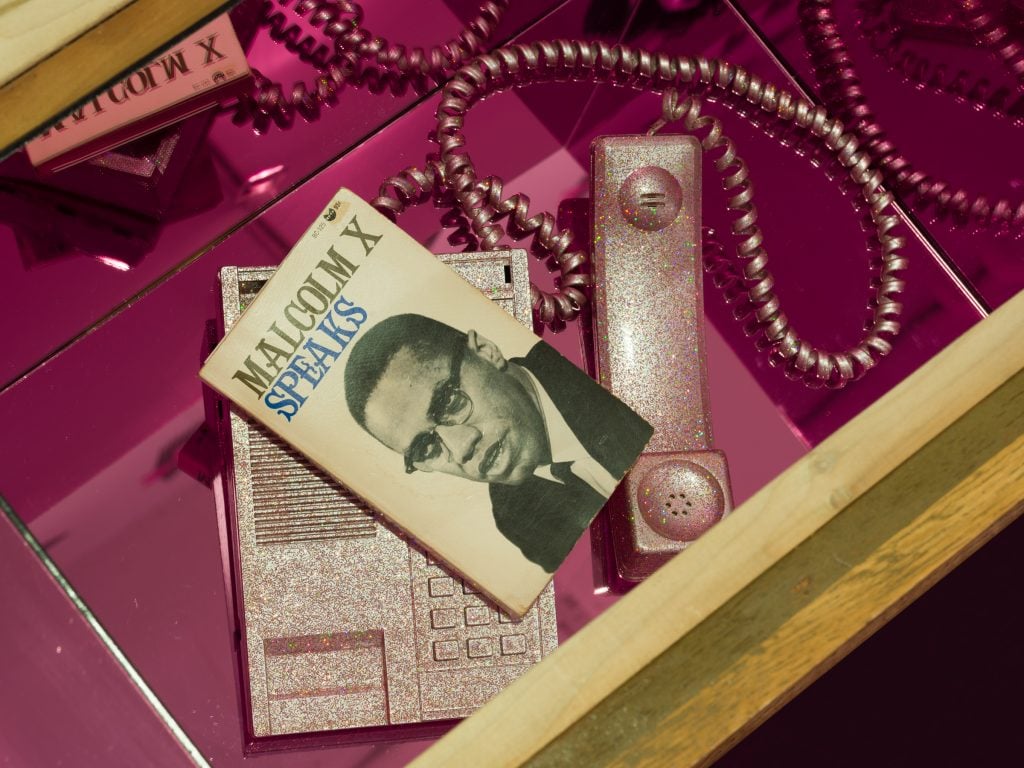
Installation view of “Sadie Barnette: Legacy and Legend” at Pitzer College Art Galleries (Lenzner Family Art Gallery) at Pitzer College, July 22–December 18, 2021. This exhibition was co-organized with the Benton Museum of Art at Pomona College. Photo: Fredrik Nilsen Studio.
While it suits her father just fine knowing that he was there and made a difference, Barnette is striving for a little bit more.
“In Sadie’s case, she’s really drawn to thinking about the way in which those who lived these experiences can be the ones that tell their own story,” says Russell.
In many ways, her work is breathing life into a history on life support. As far as official records of the New Eagle Creek Saloon, Barnette’s work is “not really reintroducing [the archive],” Silverman notes, “because there really never has been one.”
“There isn’t a National Archives for queer nightlife,” moore says. “Obviously, people have papers that might be related to queer nightlife—such as Langston Hughes, for example, whose papers are at the library and you can find some stuff in there about nightlife—but you have to sort of read between the tea leaves, if you will.”
There has been a growing contingent of artists of late, ranging from Karon Davis to Garrett Bradley, who are intent on filling in gaps within the annals of Black history. And in reevaluating the idea of what that archive can be, “the documentation of [Barnette’s] project over time is in and of itself the archive,” Russell says, becoming much more than simply “the preservation and resurrection of Rodney’s legacy, and the memory of the space that he founded.”
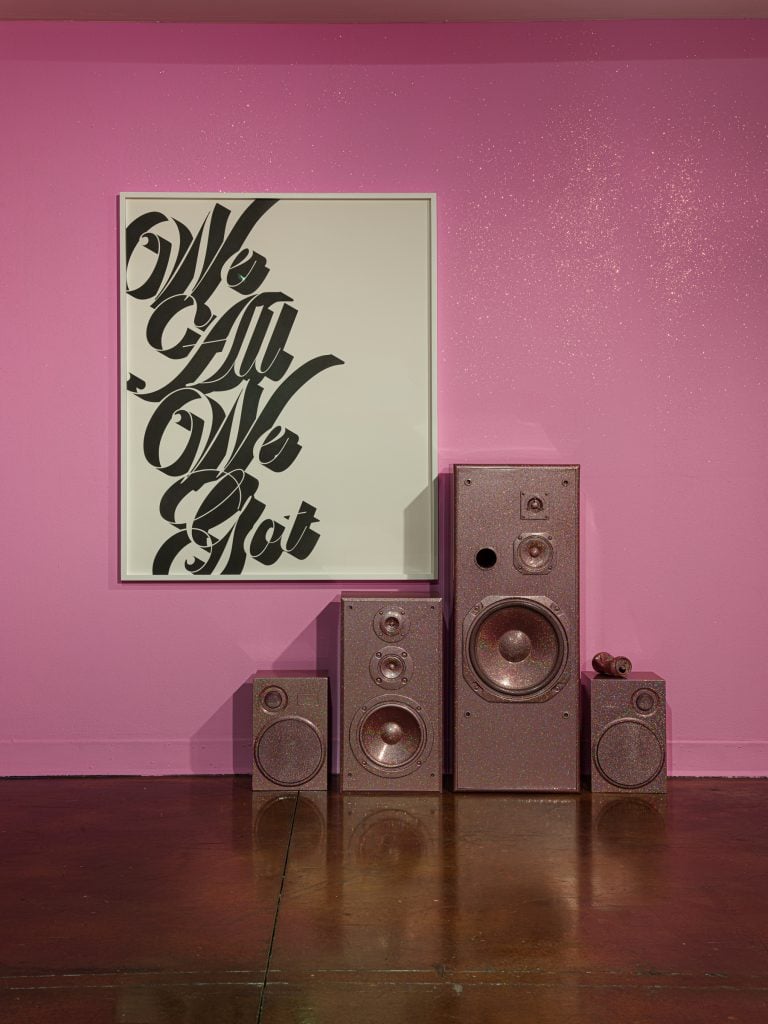
Installation view of “Sadie Barnette: Legacy and Legend” at Pitzer College Art Galleries (Lenzner Family Art Gallery), July 22 to December 18, 2021. This exhibition is co-organized with the Benton Museum of Art at Pomona College. Photography courtesy of Fredrik Nilsen Studio.
Such an archive can also be meaningfully integrated in other arenas. In bringing this installation to the Kitchen, Russell hopes to explore “a really important history that creates a through line between different parts of New York City history,” she continues, “[because] this project steps right into those intersections. It’s a project about city change and gentrification. It’s a project about the whitewashing of Black space. It’s a project about the kind of migration and journeying of Black people and Black economies.”
When Barnette takes stock of her own life, as she’s done with her father’s for her work, she realizes that she is, and always has been, a storyteller.
“The title of the show that was just at Jessica Silverman was ‘Inheritance,’” Barnette says, “and I really do think of history and stories as a type of inheritance. And it’s a gift. It’s a treasure. It’s also a responsibility.”
“Sadie Barnette: The New Eagle Creek Saloon” is on view at the Kitchen, 512 West 19th Street, New York, through March 6.